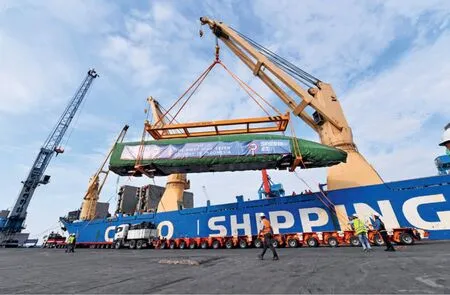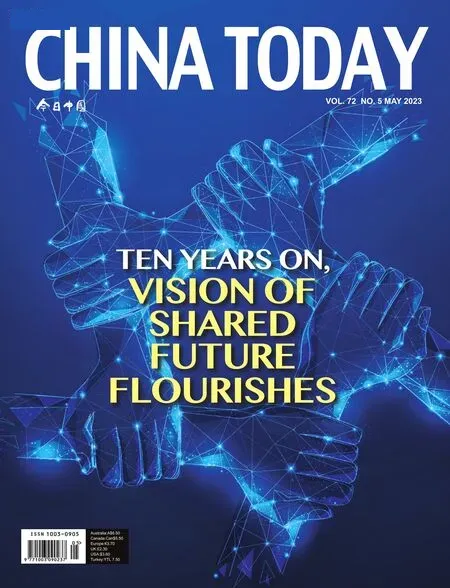The New Face of BRI Cooperation
By staff reporter ZHOU LIN

Matangi Tisa Village in Kenya’s Nakuru County is unveiled as the country’s first demonstration village for China-Africa cooperation on agricultural development and poverty reduction on October 18, 2022.lt is among the first batch of demonstration villages in Africa s et up by the Belt and Road Initiative/South-South Cooperation Agricultural Education, Science and Technology League.
The BRI proposed by China generates opportunities and benefits for the entire world.
IT’S been a decade since President Xi Jinping put forward the Belt and Road Initiative (BRI) in 2013, which consists of the overland Silk Road Economic Belt and the 21st-Century Maritime Silk Road.Over the past 10 years, China and other participating countries have made major achievements in infrastructure development, drawing up unified rules and standards, and boosting peopleto-people exchanges in various fields.The principle of extensive consultation, joint contribution, and shared benefits has received worldwide acclaim.
To mark the 10th anniversary of the BRI, the Boao Forum for Asia Annual Conference 2023 held a panel discussion themed “The Belt and Road:Sharing Opportunities of Development.”The panelists talked about the progress made over the past decade and looked forward to more high-quality development under the new round of sci-tech revolution and industrial transformation.Also, with greater international cooperation, they anticipated the building of a global community of development with a shared future to gain new momentum.
A Global Community of Development
Italy was the first Group of Seven nations to join the BRI.Paolo Borzatta, board member of the Italybased consultancy European House – Ambrosetti,said during the panel discussion that the great significance of the initiative is that it represents “the future of the world.”Besides connecting Europe,Asia and the regions beyond, its important achievements include a concensus reached among participating countries about economic cooperation.This makes the BRI not only an initiative of China or a project of the Chinese government, but also “a project of all countries along the routes, and many enterprises will benefit from it.”Looking ahead to the next 10 years, Borzatta pointed out that more connectivity and linkage mechanisms need to be established.With them, the BRI will bring more opportunities.
Kazakhstan was the place where Xi first proposed the BRI and Renat Bekturov, president of the Astana International Financial Center, detailed how the “visionary”BRI had opened a channel for Kazakhstan to connect with the entire Eurasian market.Kazakhstan’s ongoing BRI projects include the Trans-Caspian International Transport Route,known as the “Middle Corridor,”which links the rail freight transport networks of China and the European Union through Central Asia, the Caucasus,Türkiye and Eastern Europe.So far, the corridor has transported 1.5 million tons of goods, according to official data.“The BRI’s infrastructure not only provides a route to transport goods, but also has a significant impact on Kazakhstan’s economic growth,”he said.
The BRI has also given Mongolia a strong driving force for its economy.Chimed Khurelbaatar, deputy prime minister and minister of economic development of Mongolia, shared a set of data: Over the past 10 years, Mongolia has built 500 kilometers of railways connecting provincial capitals.In 2022,the nation’s foreign trade reached US $22 billion, up from less than US $10 billion a decade ago.
Besides economic benefits, the BRI also embodies China’s spirit of sharing its successful experience with other developing countries, said Ahsan Iqbal Chaudhary, Pakistan’s minister of planning, development, and special initiatives.By advocating the idea of common prosperity, China aims to promote the construction of a community with a shared future for humankind, a philosophy that appeals to many developing economies.Thanks to the China-Pakistan Economic Corridor, a flagship project under the BRI, Islamabad has access to more advanced technology and funds, and closer economic and trade exchanges with other countries, he added.
According to China’s Ministry of Commerce,China has signed cooperative agreements with more than 150 countries and over 30 international organizations, expanding the BRI circle.From 2013 to 2022, the volume of goods trade between China and countries along the BRI routes expanded from US $1.04 trillion to US $2.07 trillion, with an average annual growth of eight percent.By the end of 2022,Chinese enterprises had invested US $57.13 billion in the overseas economic and trade cooperation zones along the Belt and Road, creating 421,000 employment opportunities for locals and helping nearly 40 million people out of poverty.
Driving Digital Transformation
Without digital infrastructure, transportation facilities and electricity, there would be no effective way to reduce poverty or achieve better development, said Jim Yong Kim, former president of the World Bank Group and current vice chairman and partner at Global Infrastructure Partners, a fund that invests in infrastructure projects across the world.When the BRI was first proposed, he realized the significant role it would play in promoting human prosperity.As connectivity of infrastructure and digital solutions are crucial to facilitate trade,if all services can be digitized, the speed of goods circulation will accelerate, which will greatly reduce trade barriers between countries, he said.

A high-speed electric passenger train,customized for the Jakarta-Bandung high-speed railway, is being unloaded from a vessel in Tanjung Priok Port in Jakarta,Indonesia on September 2, 2022.
With the world undergoing the fourth industrial revolution and digitization, the way people conduct transactions and learn is changing profoundly.While the use of artificial intelligence, machine learning and advanced biotechnology is greatly enhancing productivity, at the same time, it is also bringing numerous challenges.There is a huge digital divide between developing and developed countries, which means digital transformation must be expanded from infrastructure to much broader fields.
In this regard, Borzatta suggested establishing a common agreement to coordinate digital cooperation on the Belt and Road.He also proposed developing a BRI project database for the reference of entities looking for cooperation opportunities along the routes.Multilateral institutions and international organizations such as the World Bank and the Asian Infrastructure Investment Bank (AIIB) could consider operating such a project to involve more enterprises for high-quality mutually-beneficial BRI cooperation, he said.
“Efforts should be made to strengthen cooperation in ecological and environmental protection and build a sound ecosystem so as to realize the goals set by the 2030 Agenda for Sustainable Development.”
Making Development Green
Most of the countries along the routes are developing countries and emerging economies, whose growth is highly dependent on resources.They hence face the dual task of development and environmental protection in the course of industrialization and urbanization.A green BRI is vital for highquality development.Therefore, it is urgent to build a low-carbon and environmentally friendly Silk Road which pays great attention to green infrastructure construction as well as a green financial mechanism to promote eco-environmental and livelihood projects.
Chomud Hurlebatel said it is very important for Mongolia, as a mineral-producing country, to ensure green and low-carbon growth.The Mongolian parliament will focus on developing renewable energy, including wind and solar energy, and looks forward to working with partners to build a renewable energy development system.Mongolia also looks forward to learning from China’s green development philosophy for promoting low-carbon infrastructure construction and operation, embracing the concept of ecological civilization in investment and trade,and strengthening cooperation in environmental governance,biodiversity conservation and response to climate change.“By 2030, Mongolia will plant one billion trees domestically to prevent desertification and further improve the ecological environment,”he said.
Financial institutions are also promoting a green BRI.Jin Liqun, president of the AIIB, said that the investment philosophy of emphasizing environmental, social, and governance (ESG) impacts rather than just financial performance of an enterprise or an organization represents a general trend.“Climate change and ESG assessment have already become important considerations for investment by the AIIB,”he said.“Previously, climate financing was set to account for at least 50 percent of its approved financing amount by 2025, and the current proportion has exceeded this number.”
At the first Belt and Road Forum for International Cooperation held in 2017, President Xi said,“We should pursue the new vision of green development and a way of life and work that is green, lowcarbon, circular, and sustainable.Efforts should be made to strengthen cooperation in ecological and environmental protection and build a sound ecosystem so as to realize the goals set by the 2030 Agenda for Sustainable Development.”At the second forum in 2019, he once again stressed, “We need to pursue open, green, and clean cooperation.The Belt and Road is not an exclusive club; it aims to promote green development.We may launch green infrastructure projects, make green investment, and provide green financing to protect the Earth which we all call home.”
Jin Liqun said with the acceleration of global energy transformation and the widespread idea of low-carbon development, more and more countries along the Belt and Road routes will make carbon neutrality commitments, and adopt corresponding green low-carbon development policies.

